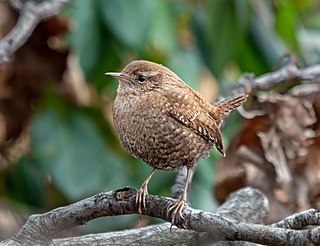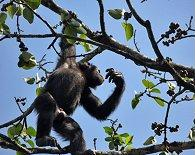
The chimpanzee, also simply known as the chimp, is a species of great ape native to the forests and savannahs of tropical Africa. It has four confirmed subspecies and a fifth proposed one. When its close relative the bonobo was more commonly known as the pygmy chimpanzee, this species was often called the common chimpanzee or the robust chimpanzee. The chimpanzee and the bonobo are the only species in the genus Pan. Evidence from fossils and DNA sequencing shows that Pan is a sister taxon to the human lineage and is thus humans' closest living relative. The chimpanzee is covered in coarse black hair, but has a bare face, fingers, toes, palms of the hands, and soles of the feet. It is larger and more robust than the bonobo, weighing 40–70 kg (88–154 lb) for males and 27–50 kg (60–110 lb) for females and standing 150 cm.

The genus Pan consists of two extant species: the chimpanzee and the bonobo. Taxonomically, these two ape species are collectively termed panins. The two species were formerly collectively called "chimpanzees" or "chimps"; if bonobos were recognized as a separate group at all, they were referred to as "pygmy" or "gracile chimpanzees". Together with humans, gorillas, and orangutans they are part of the family Hominidae. Native to sub-Saharan Africa, chimpanzees and bonobos are currently both found in the Congo jungle, while only the chimpanzee is also found further north in West Africa. Both species are listed as endangered on the IUCN Red List of Threatened Species, and in 2017 the Convention on Migratory Species selected the chimpanzee for special protection.

Wrens are a family of brown passerine birds in the predominantly New World family Troglodytidae. The family includes 88 species divided into 19 genera. Only the Eurasian wren occurs in the Old World, where, in Anglophone regions, it is commonly known simply as the "wren", as it is the originator of the name. The name wren has been applied to other, unrelated birds, particularly the New Zealand wrens (Acanthisittidae) and the Australian wrens (Maluridae).

The winter wren is a very small North American bird and a member of the mainly New World wren family Troglodytidae. The species contained the congeneric Pacific wren of western North America and Eurasian wren (Troglodytes troglodytes) of Eurasia until they were split in 2010.

The house wren is a very small bird of the wren family, Troglodytidae. It occurs from Canada to southernmost South America, and is thus the most widely distributed native bird in the Americas. It occurs in most suburban areas in its range and it is the single most common wren. Its taxonomy is highly complex and some subspecies groups are often considered separate species. The name troglodytes means "hole dweller", and is a reference to the bird's tendency to disappear into crevices when hunting insects or to seek shelter.
A troglodyte is a human cave dweller, from the Greek trogle 'hole, mouse-hole' and dyein 'go in, dive in'.

Matmata is a small Berber speaking town in southern Tunisia. Some of the local Berber residents live in traditional underground "troglodyte" structures. In 2004 it had a population of 2,116.

Troglodytes is a genus of small passerine birds in the wren family. These wrens are around 11–13 centimetres (4.3–5.1 in) long. They are brownish above and somewhat paler below, with strong legs. Their short rounded wings and frequently cocked tail have a dark barred pattern. The flight is direct and buzzing.
The Troglodytae, or Troglodyti, were people mentioned in various locations by many ancient Greek and Roman geographers and historians, including Herodotus, Agatharchides, Diodorus Siculus, Strabo, Pliny, Josephus, Tacitus, Claudius Aelianus, Porphyry.

The St Kilda wren is a small passerine bird in the wren family. It is a distinctive subspecies of the Eurasian wren endemic to the islands of the isolated St Kilda archipelago, in the Atlantic Ocean 64 kilometres (40 mi) west of the Outer Hebrides, Scotland.
The Fair Isle wren is a small passerine bird in the wren family. It is a subspecies of the Eurasian wren endemic to Fair Isle, Shetland, Scotland, an island about halfway between mainland Shetland and Orkney. It was first described by the British ornithologist Kenneth Williamson in 1951.
The Shetland wren is a small passerine bird in the wren family. It is a subspecies of the Eurasian wren endemic to the Shetland archipelago of Scotland, with the exception of Fair Isle which has its own endemic subspecies, the Fair Isle wren. The Shetland wren is distinguished by its darker and more rufous-brown colouring from the mainland form, with a heavily barred underside, the barring extending from belly to breast. The bill is stouter and longer and it has stronger legs.

The western chimpanzee or West African chimpanzee is a Critically Endangered subspecies of the common chimpanzee. It inhabits western Africa, specifically Côte d'Ivoire, Guinea, Liberia, Mali, Senegal, Ghana, Guinea-Bissau, but has been extirpated in three countries: Benin, Burkina Faso, and Togo.

The Eurasian wren or northern wren is a very small insectivorous bird, and the only member of the wren family Troglodytidae found in Eurasia and Africa (Maghreb). In Anglophone Europe, it is commonly known simply as the wren. It has a very short tail which is often held erect, a short neck and a relatively long thin bill. It is russet brown above, paler buff-brown below and has a cream buff supercilium. The sexes are alike.

The Pacific wren is a very small North American bird and a member of the mainly New World wren family Troglodytidae. It was once lumped with Troglodytes hiemalis of eastern North America and Troglodytes troglodytes of Eurasia as the winter wren.

Bone Tomahawk is a 2015 American Western film written and directed by S. Craig Zahler in his directorial debut, and starring Kurt Russell, Patrick Wilson, Matthew Fox, Richard Jenkins, Lili Simmons, Evan Jonigkeit, David Arquette, Zahn McClarnon and Sid Haig. It was produced by Jack Heller and Dallas Sonnier. The film is about a small-town sheriff who leads a posse into a desolate region to rescue three people who were abducted by a cannibalistic Native American clan.
Spilomena hainesi is a species of aphid wasp in the family Pemphredonidae. It is found in North America.
Spilomena occidentalis is a species of aphid wasp in the family Pemphredonidae. It is found in North America.

Cave dwelling Jews, also cave Jews or troglodyte Jews, were Jewish communities that dwelled in man-made caves in the mountains. The best known communities of this type existed in the Gharyan Plateau area of the Nafusa Mountains in Libya, and are commonly referred to as Gharyan Jews. These communities no longer exist today.













